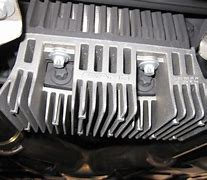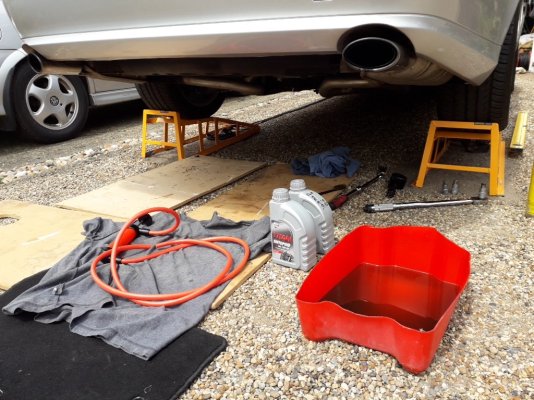MrGreedy
MB Enthusiast
Just changed the rear diff oil on the w212.
Mercedes Bevo shows Fuchs Titan Sintopoid FE 75W-85 as an approved fluid, picked up on black Friday from Opie oils for around £10 per litre bottle (you need two). I bet that is the fluid Merc actually put in their bottles. See my recent power steering fluid thread snd Bevo link strongly suggesting Fuchs are the only approved supplier of PAS fluid, so Fuchs are obviously used alot by Merc.
The drain and fill plugs on the diff are both 14mm hex key (like a large allen key shape). I have a Laser sump key set, and it has a 14mm sump key socket on a 3/8" square ratchet drive that fitted in the plug head. Give the drain plugs a good cleaning and a squirt with penetrating fluid at least 15mins before trying to undo then.
I found by using a 3/8" ratchet, it fitted in the space between the exhaust, and no wobble universal coupler was needed.
I didn't want to jack on the diff so I used this method, but I can't recommend this to anyone as I can't vouch for jack safety. Really, I'd only be properly comfortable doing this job on MOT ramps or a 4-post lift.
I know a lot of people will say use axle stands, but you then have to risk jacking up just via the diff (that is corroding now after 12 years) and I wouldn't feel any safer under two tiddly axle stands that have a relatively narrow base (compared with e.g. a wheel and 3ft of railway sleeper). My personal view is that a wheel properly under the sill and the super chunky, square cut timber under the rear subframe could easily support the weight of the car if the jack let go. The clearance I had between the sill and the wheel, and between the timber and the subframe was less than 5mm, so any 'drop' would be very small.
I jacked up the passenger side rear, removed the rear wheel and put that halfway under the car, under the sill and as close to the jack as possible, and then put a couple of massive offcuts of railway sleeper under the rear subframe. Whilst being watched by an assistant who was fully briefed in the use of the jack, I whipped under the car and cracked the fill plug loose and got back out. About 10 seconds.
Re-attached wheel and lowered back to ground.
I then jacked up the driver's side, same process as above with wheel under the sill and railway sleepers under the rear subframe. Whipped under whilst supervised and fully undid the drain plug (which of course I dropped into the the oil catch pan). About 20 seconds under the car.
I then lowered this side very carefully on the jack so that the diff was sloping slightly down towards the drain hole.
Once drained (left about 20 mins), I jacked the car back up again with associated wheel and railway sleepers in position, and put the drain plug back in from under the car. About 20 seconds.
Then wheel back on the driver's rear and lowered back down.
Now back over to the passerger side rear, jacked up and wheel off and put under the sill, plus railway sleepers again. I could reach through between the brake disc and the front of the rear wheel arch with a couple of socket extensions to remove the fill plug and also reach through to the fill hole with a giant oil syringe/extractor with about 2ft of clear, stiff poly hose, and filled diff up, all without getting under the car (noting that the car is sloping away from the fill hole, which results in a slight overfill of diff oil.
I then lowered the car so it was level, so the excess oil could drain out to the correct level.
Jacked car back up again, wheel under sill etc, and then whipped under the car for another 30 seconds of fitting the plug and a quick whip round with some baby wipes to clean up.
All this wheel on wheel off, jack up, lower, repeat, repeat, stretched the job out to around 90 minutes, but I felt more comfortable with a car with 3 wheels on the ground, wheel under sill plus railway sleepers, and front wheels chocked, than having the rear fully up in the air on both sides via axle stands, particularly as on these rear wheel drive cars, the front wheels are not restricted with gears or handbrake.
Mercedes Bevo shows Fuchs Titan Sintopoid FE 75W-85 as an approved fluid, picked up on black Friday from Opie oils for around £10 per litre bottle (you need two). I bet that is the fluid Merc actually put in their bottles. See my recent power steering fluid thread snd Bevo link strongly suggesting Fuchs are the only approved supplier of PAS fluid, so Fuchs are obviously used alot by Merc.
The drain and fill plugs on the diff are both 14mm hex key (like a large allen key shape). I have a Laser sump key set, and it has a 14mm sump key socket on a 3/8" square ratchet drive that fitted in the plug head. Give the drain plugs a good cleaning and a squirt with penetrating fluid at least 15mins before trying to undo then.
I found by using a 3/8" ratchet, it fitted in the space between the exhaust, and no wobble universal coupler was needed.
I didn't want to jack on the diff so I used this method, but I can't recommend this to anyone as I can't vouch for jack safety. Really, I'd only be properly comfortable doing this job on MOT ramps or a 4-post lift.
I know a lot of people will say use axle stands, but you then have to risk jacking up just via the diff (that is corroding now after 12 years) and I wouldn't feel any safer under two tiddly axle stands that have a relatively narrow base (compared with e.g. a wheel and 3ft of railway sleeper). My personal view is that a wheel properly under the sill and the super chunky, square cut timber under the rear subframe could easily support the weight of the car if the jack let go. The clearance I had between the sill and the wheel, and between the timber and the subframe was less than 5mm, so any 'drop' would be very small.
I jacked up the passenger side rear, removed the rear wheel and put that halfway under the car, under the sill and as close to the jack as possible, and then put a couple of massive offcuts of railway sleeper under the rear subframe. Whilst being watched by an assistant who was fully briefed in the use of the jack, I whipped under the car and cracked the fill plug loose and got back out. About 10 seconds.
Re-attached wheel and lowered back to ground.
I then jacked up the driver's side, same process as above with wheel under the sill and railway sleepers under the rear subframe. Whipped under whilst supervised and fully undid the drain plug (which of course I dropped into the the oil catch pan). About 20 seconds under the car.
I then lowered this side very carefully on the jack so that the diff was sloping slightly down towards the drain hole.
Once drained (left about 20 mins), I jacked the car back up again with associated wheel and railway sleepers in position, and put the drain plug back in from under the car. About 20 seconds.
Then wheel back on the driver's rear and lowered back down.
Now back over to the passerger side rear, jacked up and wheel off and put under the sill, plus railway sleepers again. I could reach through between the brake disc and the front of the rear wheel arch with a couple of socket extensions to remove the fill plug and also reach through to the fill hole with a giant oil syringe/extractor with about 2ft of clear, stiff poly hose, and filled diff up, all without getting under the car (noting that the car is sloping away from the fill hole, which results in a slight overfill of diff oil.
I then lowered the car so it was level, so the excess oil could drain out to the correct level.
Jacked car back up again, wheel under sill etc, and then whipped under the car for another 30 seconds of fitting the plug and a quick whip round with some baby wipes to clean up.
All this wheel on wheel off, jack up, lower, repeat, repeat, stretched the job out to around 90 minutes, but I felt more comfortable with a car with 3 wheels on the ground, wheel under sill plus railway sleepers, and front wheels chocked, than having the rear fully up in the air on both sides via axle stands, particularly as on these rear wheel drive cars, the front wheels are not restricted with gears or handbrake.
Last edited:


